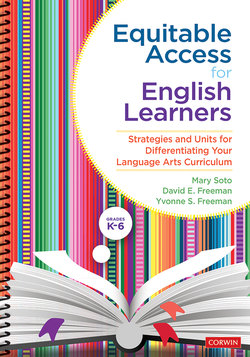Читать книгу Equitable Access for English Learners, Grades K-6 - Mary Soto - Страница 9
На сайте Литреса книга снята с продажи.
Chapter One Foundations for the equitable access approach for english learners Mandated Language Arts Programs
ОглавлениеAcross the country, teachers are faced with the challenge of teaching multilingual, multicultural learners following state and district Standards. Elementary language arts teachers, in particular, are required to meet Standards that are aligned with standardized tests used to measure school and teacher effectiveness. School district administrators, pressured by their local communities to have exemplary schools, look for materials and programs that guarantee success.
Publishers have responded to these demands by producing language arts materials that claim to meet state Standards and claim to include everything teachers need to ensure that all their students will succeed when evaluated. Most programs used in schools are referred to as basal readers or core reading programs and are meant to provide a sequenced approach to reading instruction through textbooks and supplemental materials that include readings (often excerpts from children’s literature) and skills instruction.
Basal programs regularly include claims that they have research evidence showing their programs promote the success of all students. However, several studies have brought these claims into question. With the adoption of the Common Core State Standards (CCSS), expectations for all students, including emergent bilinguals, are much higher.
As Fu and her colleagues point out, the new Standards “put pressure on EB’s [emergent bilinguals] capabilities and prove more taxing for their long-term success” (Fu, Hadjioannou, & Zhou, 2019, p. 22). In California and New York, the two states with the highest numbers of English learners, only 25% and 29% of ELs met grade-level expectations. Further, “Emergent bilingual students scored markedly worse on the California Standardized Test where, in the 2nd grade, there was a 20% disparity between EBs and their English proficient counterparts (45% EB versus 64% English proficient passing rate)” (Fu, Hadjioannou, & Zhou, 2019, p. 22).
Although basal programs claim they contain all the components needed for every student to succeed, in his article “The Problem With Literacy Programs,” published in Education Week, Schmoker states:
We must reckon with the fact that even popular, highly praised commercial programs often lack a robust evidence base. That’s because they are deficient in precisely those aspects most critical to acquiring the ability to read, write, and speak well. Instead, they abound in busywork. (p. 18)
Schmoker points out that while programs may be well-designed, they are often poorly implemented and do not provide time for students to read, write, and discuss text. Rather, they engage students in many worksheets both on paper and in electronic form.
Several companies have developed programs that are alternatives to basal programs. These alternative comprehensive literacy programs are usually developed following key shifts in curriculum and instruction. They are designed to meet the rigor and expectations of the new Standards and are meant to be more meaningful for students. However, it is difficult for any program to be appropriate for all students.
In 2010, Education Market Research reported that 74% of classroom teachers used district- or school-adopted basal reading programs (Dewitz & Jones, 2012). This percentage of teachers using basal reading programs published by major publishing companies such as Houghton Mifflin Harcourt and Macmillan/McGraw-Hill has remained at around 70% for a number of years. The remaining districts or schools either adopt alternative literacy programs that also are considered comprehensive literacy programs or work with their teachers using authentic literature and develop their own units connected to Standards.
Using basal programs has pros and cons. They are chosen for a variety of reasons (Dewitz, Leahy, & Jones, 2010; Y. Freeman, 1988a; Goodman, Shannon, Freeman, & Murphy, 1988; Shanahan, 2016):
